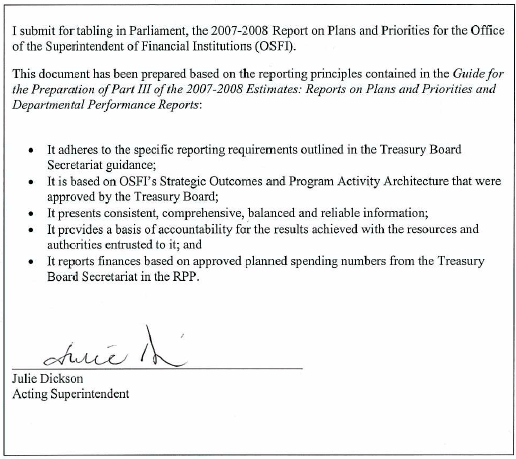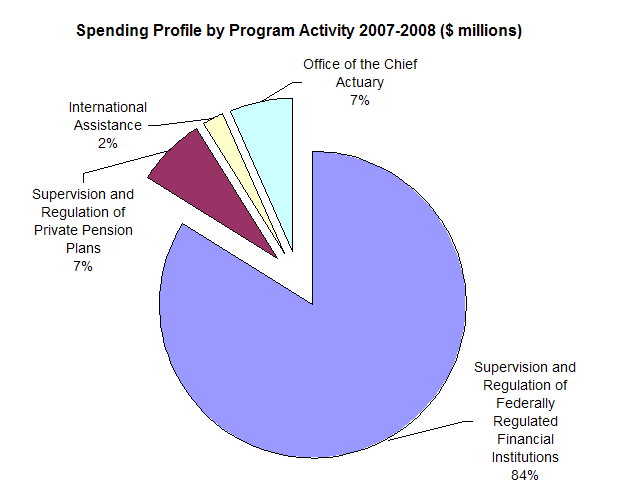Common menu bar links
Breadcrumb Trail
ARCHIVED - RPP 2007-2008
Office of the Superintendent of Financial Institutions Canada
 This page has been archived.
This page has been archived.
Archived Content
Information identified as archived on the Web is for reference, research or recordkeeping purposes. It has not been altered or updated after the date of archiving. Web pages that are archived on the Web are not subject to the Government of Canada Web Standards. As per the Communications Policy of the Government of Canada, you can request alternate formats on the "Contact Us" page.
Section I: OVERVIEW
Message from the Acting Superintendent

I am pleased to present the Report on Plans and Priorities (RPP) for the Office of the Superintendent of Financial Institutions (OSFI) for the years 2007-2008 to 2009-2010.
Canada possesses one of the strongest financial systems in the world, which contributes to the strength and innovation of our economy, and protects the savings of individual Canadians. However, the domestic and international environments are fluid. Maintaining high confidence in the safety of money entrusted to Canadian financial institutions and remaining a world-class prudential regulator with a modern supervisory system figure prominently in OSFI’s plans and priorities.
OSFI’s plans and priorities support our strategic outcomes of contributing to public confidence in Canada’s financial system and in Canada’s public retirement system. These outcomes are intrinsically aligned with broader government outcomes, specifically strong economic growth, income security for Canadians, and a safe and secure world through international cooperation.
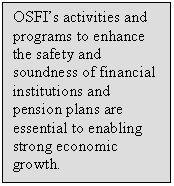
OSFI is the primary regulator and supervisor of about 450 federally registered financial institutions, as well as some 1,300 federally regulated private pension plans. Effective mechanisms for evaluating risks, programs to promote sound business and financial practices, and the capacity to intervene early to avoid or minimize prudential problems will continue to be the key ingredients of OSFI’s regulatory and supervisory approach. These activities and programs to enhance the safety and soundness of financial institutions and pension plans are essential to enabling strong economic growth.
Financial institutions operate in an increasingly complex, international environment. There is greater interest in increased cross-border cooperation, and OSFI will continue to develop relationships with foreign regulators to promote consistency and facilitate mutual reliance. Through guidance and the supervisory review of financial institution programs to comply with anti-money laundering and anti-terrorism financing requirements, OSFI supports the government’s priority for a safe and secure world through international cooperation.
The regulatory and legal environments are changing rapidly as institutions are faced with new accounting standards and the implementation of Basel II. Basel II is an international framework for a new set of standards for minimum capital requirements for banking organizations, which Canadian banks will implement in November 2007.
Canadian banks and OSFI are well advanced with implementation efforts, but continued focus and ongoing work will be required over the next few years.
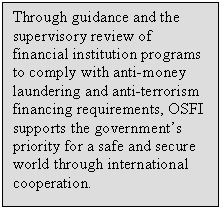
The Canadian Accounting Standards Board is adopting International Financial Reporting Standards (IFRS) over the next five years. This will have an impact on both OSFI, as it relies on audited financial information, and the institutions it regulates. The areas that most impact our institutions are insurance, consolidation, business combinations, pensions, revenue recognition and measurement of fair value. The assessment of the impact and the implementation of IFRS is a key priority for the planning period.
Financial and economic conditions continue to create a challenging environment for the pension industry. Long-term interest rates remain low. The Canadian pension environment is increasingly litigious. OSFI will continue to monitor court decisions affecting pension plans to assess the implications on federally regulated pension plans and take action where required. In addition, OSFI will focus on process improvements with respect to federally regulated private pension plans.
While the current environment has been favourable for financial institutions, problems can develop quickly if they become complacent in the application of sound criteria used in their investment and lending activities. To meet its mandate OSFI needs to be fully prepared to identify and deal with problem institutions, particularly small ones. For larger institutions, OSFI will emphasize financial institutions’ stress testing capabilities. This is part of OSFI’s day-to-day work, however, more focus will be placed in this area.
To ensure that OSFI is able to respond adequately to shocks to the economy as a result of a crisis or pandemic, it will conduct exercises in crisis planning and business resumption planning. OSFI is also planning its own response to a pandemic, as well as reviewing financial institutions preparedness for a pandemic.
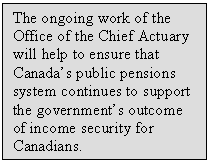
As a separate unit within OSFI, the Office of the Chief Actuary (OCA) provides actuarial and other services to the federal government. The OCA provides appropriate checks and balances on the future costs of the different pension plans and social programs that fall under its responsibilities. The ongoing work of the OCA will help to ensure that Canada’s public pensions system continues to support the government’s outcome of income security for Canadians.
OSFI’s activities will continue to form part of a modern infrastructure that supports Canada’s financial system and economy. The vitality of both is essential to improving the quality of life for all Canadians, which is the Government of Canada’s enduring priority.
Management Representation Statement
Summary Information
OSFI’s Raison d’être
Mandate
OSFI's legislated mandate was established in 1996 and changes are not expected in the 2007-2010 planning period. Under the legislation, OSFI’s mandate is to:
- Supervise federally regulated financial institutions and private pension plans to determine whether they are in sound financial condition and meeting minimum plan funding requirements respectively, and are complying with their governing law and supervisory requirements;
- Promptly advise institutions and plans in the event there are material deficiencies and take, or require management, boards or plan administrators to take, necessary corrective measures expeditiously;
- Advance and administer a regulatory framework that promotes the adoption of policies and procedures designed to control and manage risk;
- Monitor and evaluate system-wide or sectoral issues that may impact institutions negatively.
In meeting this mandate, OSFI contributes to public confidence in the financial system.
OSFI’s legislation also acknowledges the need to allow institutions to compete effectively and take reasonable risks. It recognizes that management, boards of directors and plan administrators are ultimately responsible and that financial institutions and pension plans can fail.
The Office of the Chief Actuary (OCA), which is part of OSFI, provides actuarial services to the Government of Canada.
Strategic OutcomesPrimary to OSFI’s mission and central to its contribution to Canada’s financial system are two strategic outcomes:
- To regulate and supervise to contribute to public confidence in Canada’s financial system and safeguard from undue loss. OSFI safeguards depositors, policyholders and private pension plan members by enhancing the safety and soundness of federally regulated financial institutions and private pension plans.
- To contribute to public confidence in Canada's public retirement income system. This is achieved through the activities of the Office of the Chief Actuary, which provides high-quality, timely advice on the state of various public pension plans and on the financial implications of options being considered by policy makers.
Financial Resources ($ millions)
|
2007-2008 |
2008-2009 |
2009-2010 |
|
$90.5 |
$91.3 |
$102.8 |
Human Resources Average Full-Time Equivalents (FTEs)
|
2007-2008 |
2008-2009 |
2009-2010 |
|
461 |
459 |
459 |
|
Strategic Outcome |
Program Activities |
Planned Spending |
||
|
2007-2008 |
2008-2009 |
2009-2010 |
||
| 1. To regulate and supervise to contribute to public confidence in Canada’s financial system and safeguard from undue loss. | 1.1 Regulation and Supervision of Federally Regulated Financial Institutions |
$75.9 |
$76.3 |
$87.5 |
|
1.2 Regulation and Supervision of Federally Regulated Private Pension Plans |
$6.5 |
$6.8 |
$7.0 |
|
|
1.3 International Assistance |
$2.0 |
$2.1 |
$2.1 |
|
|
2. To contribute to public confidence in Canada's public retirement income system. |
2.1 Office of the Chief Actuary (OCA) |
$6.1 |
$6.1 |
$6.2 |
In addition to key ongoing responsibilities required to meet the mandate (as listed in the above program activities), OSFI has identified the following priorities for the planning period.
Priorities
|
Priority |
Type |
| A. Readiness Planning | New |
|
B. Basel II |
Previously committed |
|
C. Financial Sector Assessment Program (FSAP) / Financial Action Task Force (FATF) |
New |
|
D. Accounting Standards |
Previously committed |
|
E. Minimum Continuing Capital Surplus Requirement (MCCSR) |
New |
|
F. Pension Systems and Processes |
New |
|
G. Integration of Human Resources Planning into Business Planning |
New |
Program Activities by Strategic Outcome
|
|
Expected Results |
Planned Spending |
|||
|
2007-2008 |
2008-2009 |
2009-2010 |
Links to the following priority |
||
|
Strategic Outcome 1
To regulate and supervise to contribute to public confidence in Canada’s financial system and safeguard from undue loss. |
|||||
|
Program Activity 1.1 Regulation and supervision of federally regulated financial institutions |
|
|
|
|
|
|
Sub-activity 1.1.1 Risk assessment and intervention |
Accuracy of risk assessment and early intervention; effective support and facilitation for Basel II implementation. |
$53.5 |
$53.8 |
$61.6 |
Priorities A, B, C and G |
|
Sub-activity 1.1.2
Rule making |
Balanced regulatory framework; prudent capital rules and regulatory reporting and alignment with other jurisdictions. |
$14.7 |
$14.8 |
$17.0 |
Priorities D, E and G |
|
Sub-activity 1.1.3 Approvals |
Prudentially sound and responsive approvals process. |
$7.7 |
$7.7 |
$8.9 |
Priority G |
|
Program Activity 1.2 Regulation and Supervision of Federally Regulated Private Pension Plans |
Accuracy of risk assessment and early intervention. |
$6.5 |
$6.8 |
$7.0 |
Priority F and G |
|
Program Activity 1.3 International Assistance |
Improved supervisory and regulatory practices for foreign regulators. |
$2.0 |
$2.1 |
$2.1 |
Priority G |
|
Strategic Outcome 2 To contribute to public confidence in Canada's public retirement income system. |
|||||
|
Program Activity 2.1 Office of the Chief Actuary |
Expert and timely actuarial valuations and advice. |
$6.1 |
$6.1 |
$6.2 |
Priority G |
Note: Program Support consisting of Human Resources, Finance, Contracting, Procurement and Information Technology is considered part of every Program Activity.
Program ActivitiesThe following diagram shows how OSFI’s ongoing activities, key outputs and expected results are linked to strategic outcomes, with resources for 2007-2008.
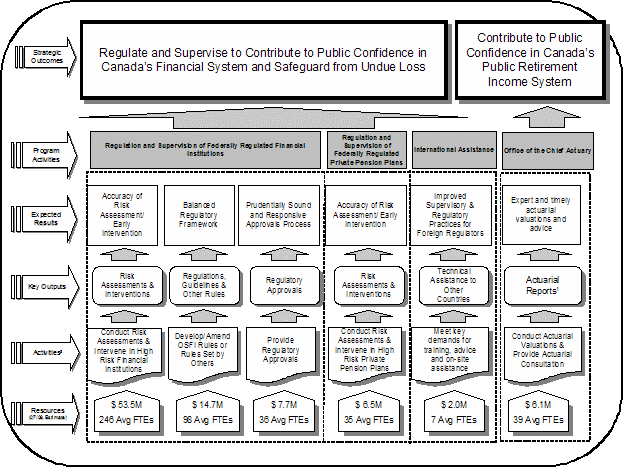
1 Canada Pension Plan, Old Age Security, Canada Student Loans Program, and various public-sector pension and insurance plans.
2 These activities are supported by organization-wide activities. Corporate Services costs and FTEs are allocated across the activities based on direct human resources costs.
Program Activities
Three program activities support OSFI’s first strategic outcome, to regulate and supervise financial institutions and pension plans so as to contribute to public confidence. A fourth program activity supports OSFI’s second strategic outcome, to contribute to public confidence in Canada’s public retirement income system.
1. Regulation and supervision of federally regulated financial institutions (FRFIs)
This program activity is central to the achievement of OSFI’s mandate to protect the rights and interests of depositors and policyholders and to advance a regulatory framework that contributes to confidence in the Canadian financial system. The three sub-activities of this program are:
- Risk assessment and intervention includes activities to monitor and supervise financial institutions, monitor the financial and economic environment to identify emerging issues and intervene in a timely way to protect depositors and policyholders, while recognizing that all failures cannot be prevented.
- Rule making encompasses the issuance of guidance and regulations, input into federal legislation affecting financial institutions, contributions to accounting, auditing and actuarial standards, and involvement in a number of international rule-making activities.
- Approvals of certain types of actions or transactions undertaken by regulated financial institutions. This covers two distinct types of approvals: those required under the legislation applying to financial institutions, and approvals for supervisory purposes.
There is a strong interrelationship among the three parts of this supervisory and regulatory program. The supervisory function relies on an appropriate framework of rules and guidance. In some situations, regulatory approval is required because a proposed transaction may significantly affect an institution’s risk profile. Approving such a change involves both a supervisory and regulatory assessment. Supervisory experiences often identify areas where new or amended rules are needed.
As identified in OSFI’s mandate, OSFI must also recognize the need for financial institutions to compete effectively. The sustainability and success of regulated institutions is important for the long-term safety and soundness of the financial system. As a result, OSFI needs to strike an appropriate balance between promoting prudence and allowing financial institutions to take reasonable risks in order to compete and prosper.
2. Regulation and supervision of federally regulated private pension plans
This program activity incorporates risk assessment, intervention, rule making and approvals related to federally regulated private pension plans under the Pension Benefits Standards Act, 1985.
3. International Assistance
OSFI supports initiatives of the Government of Canada to assist emerging market economies to strengthen their regulatory and supervisory systems. This program activity is largely funded by the Canadian International Development Agency, and is carried out directly by OSFI and through its participation in the Toronto International Leadership Centre for Financial Sector Supervision.
4. Office of the Chief Actuary
The activities of the Office of the Chief Actuary (OCA) supports OSFI’s second strategic outcome. The OCA provides a range of actuarial services, under legislation, to the Canada Pension Plan (CPP) and some federal government departments, including the provision of expert and timely advice in the form of reports tabled in Parliament. The basic elements of this program include:
- Canada Pension Plan and Old Age Security. The OCA estimates long-term expenditures, revenues and current liabilities of the CPP and long-term future expenditures for Old Age Security programs, and prepares statutory triennial actuarial reports on the financial status of these programs.
- Other Public Pension and Insurance Plans. The OCA prepares statutory triennial actuarial reports on the financial status of federal public sector employee pension and insurance plans covering the federal Public Service, the Canadian Armed Forces, the Royal Canadian Mounted Police, federally appointed judges and Members of Parliament.
- Canada Student Loans. Since 2001, the OCA undertakes the actuarial review of the Canada Student Loans Program by evaluating the portfolio of loans and the long-term costs of the program.
Whenever a bill is introduced before Parliament that has a material impact on the financial status of a public pension plan falling under the statutory responsibilities of the Chief Actuary, the OCA must submit an actuarial report valuing the impact to the appropriate minister. The OCA also provides actuarial information on the CPP to provincial governments, which are the plan's co-stewards. Meaningful steps have been taken since the late 1990s to strengthen the transparency and accountability of actuarial reporting on the CPP. In particular, the frequency of actuarial reporting on the CPP has been increased to every three years instead of five. Also, stakeholders of the CPP endorsed plans to establish regular peer reviews of actuarial reports on the CPP, and the first such review was completed in 2005.
OSFI’s Accountability Framework
OSFI was created in 1987 through the enactment of the Office of the Superintendent of Financial Institutions Act (OSFI Act), and subsequently received a legislated mandate that clarified its objectives in the regulation and supervision of federal financial institutions and private pension plans. The OSFI Act provides that the Minister of Finance is responsible for OSFI. It also provides that the Superintendent is solely responsible for exercising the authorities provided to him by the financial legislation, and is required to report to the Minister of Finance from time to time on the administration of the financial institutions legislation.
OSFI's accountability framework is made up of a variety of elements. For example, a country can request a comprehensive assessment of its financial systems through the Financial System Assessment Program (FSAP), a voluntary joint IMF -World Bank initiative. OSFI participated in Canada’s 1999 FSAP and is participating in an FSAP Update in 2007. A key component is an assessment of OSFI’s compliance with international banking standards and codes. Further, a country can request an independent assessment of its implementation of anti-money laundering and anti-terrorist financing standards by the Financial Action Task Force (FATF), an inter-governmental body who develops and promotes policies in this area. OSFI is participating in Canada’s first FATF review in 2007.
OSFI regularly conducts anonymous surveys of knowledgeable observers, i.e., industry executives and professionals, on its operations, both on individual activities and on broader issues such as OSFI's contribution to public confidence and how OSFI compares to other regulators. Survey results are disclosed on OSFI’s web site under About OSFI / Reports / Consultations.
OSFI consults extensively on its regulatory rules before they are finalized, with financial institutions, other government agencies and subject-matter experts, among others. OSFI has implemented a range of measures that allow it to assess performance. OSFI has its financial statements and related control processes audited annually. Its financial statements are included in its annual report, which is published on OSFI’s web site under About OSFI / Reports / Annual Reports.
OSFI’s internal audit group conducts assurance audits based on a comprehensive five-year risk-based plan. Audit results are reviewed by the Executive and the Audit Committee at regularly scheduled meetings. OSFI strengthened its internal audit program considerably in 2006-2007 in accordance with the new TBS audit policy. Effective the first quarter of 2006, OSFI appointed four external members to its Audit Committee, who serve with the Superintendent. The independent members represent a majority of the committee. In addition, more resources were added to the internal audit program. More information is available on OSFI’s web site under About OSFI / Audit Committee.
The activities of the Office of the Chief Actuary within OSFI contribute to confidence in the retirement income system, through the provision of accurate, timely information on the state of public pension plan arrangements and options being considered by policy makers. The accountability framework for the OCA established by OSFI makes clear that the Chief Actuary is the person solely responsible for the actuarial opinions made by the Office. More information is available on OSFI’s web site under the Office of the Chief Actuary.
Operating Environment
Regulated Entities
OSFI supervises and regulates all federally incorporated or registered deposit-taking institutions (e.g., banks), life insurance companies, property and casualty insurance companies, and federally regulated private pension plans. These 1,759 organizations managed a total of $2,887 billion of assets (as at March 31, 2006).
Federally Regulated Financial Institutions and Private Pension Plans & Related Assets
|
|
Deposit- Taking Institutions |
Life Insurance Companies |
Property & Casualty Companies |
Private Pensions Plans |
Total |
|
Number of organizations |
147 |
119 |
189 |
1,304 |
1,759 |
|
Assets $B |
2,292 |
388 |
91 |
116 |
2,887 |
OSFI also undertakes supervision of provincially incorporated financial institutions on a cost-recovery basis under contract arrangements with some provinces. Additional detail may be found on OSFI’s website under About OSFI / Who We Regulate.
Environmental Assessment
For planning purposes, OSFI conducts an annual assessment of the overall economic and financial conditions in Canada and abroad and consults with the Bank of Canada and the Department of Finance on their macroeconomic forecasts. In addition, OSFI’s assessment reflects input from international sources (such as the Financial Stability Forum and other regulators). These sources supplement information derived from OSFI’s own experiences with its regulatory and supervisory programs, and from assessments made from our internal Enterprise Risk Management (ERM) activities.
Economic OutlookThe North American economy is slowing but still growing. With uncertainty about whether the credit cycle has peaked, low unemployment and benign inflation numbers, economic analysts have been hard pressed to generate economic forecasts. The general consensus is that expansion will continue through 2007, but at a moderate pace, although there are risks to consider and some indicators of possible changes to come.
The Canadian economy has been driven by personal expenditures, including housing. According to Standard and Poor’s, Canadian consumers have been spending almost all of their income. The personal saving rate reached a new low of 1% in 2005 before rebounding to 1.9% on strong personal income growth early in 2006. Demand for consumer and mortgage credit continues to expand, with household debt rising to 120.6% as a share of disposable income. However, rising asset values, particularly house prices, have kept the share of household debt to total assets relatively stable at 18.4%.
The increase in interest rates that took place in the first half of 2006 will produce some moderation in consumption growth in 2007. Canadian producers have been and are expected to continue investing in productivity-enhancing machinery and equipment. Provided that the global economy is able to maintain its dynamism, the Canadian economy should continue to experience solid growth.
The external risks to this outlook include: geopolitical problems; terrorism; a correction in energy prices; the U.S. trade deficit; and a major problem in the U.S. economy resulting from a possible cooling-off in housing markets.
Residential property prices in the U.S. have risen sharply over the past five years, and much of consumers' wealth is tied up in their homes. The U.S. housing sector is in a slump, with new home sales in July 2006 being 22% below July 2005. Existing home sales were down to 6.33 million in July 2006 from over seven million at the end of 2005. A sharp real estate plunge in the U.S. could reduce consumers' incentive to spend elsewhere. In 2006, housing markets in Canada were quite active, with some concerns that prices were not sustainable, but these concerns have since moderated.
Drops in business and consumer confidence outside Canada also support a more pessimistic view of the future. According to a Moody’s Economy.com international survey, global confidence is near a three-year low, and is consistent with global growth that is below its potential. The U.S. Conference Board Confidence Survey, based on a sample of 5,000 U.S. households, also suggests that American consumer confidence is low. Despite a slight rise towards the end of 2006, it is too soon to tell if this boost in confidence is a genuine signal that better times are ahead.1
1 More information on the U.S. indicators can be found on Moody’s web site at www.economy.com or on the U.S. Conference Board web site at www.conference-board.org.
Within Canada, consumer confidence fell in Ontario and Quebec in December 2006, and remained well below that of western consumers, the Conference Board of Canada reported in their Index of Consumer Confidence. Business is more optimistic. According to the Bank of Canada Winter 2006-2007 Business Outlook Survey, the balance of opinion regarding future sales growth is slightly positive. Overall, firms in Central and Eastern Canada expect an improvement in their sales growth. Many firms in Western Canada do not expect to surpass the recent high rates of growth.2
2 More information on the Canadian indicators can be found on the Conference Board of Canada web site at www.conferenceboard.ca, and the Bank of Canada web site at www.bankofcanada.ca.
Industry and Regulatory Environment
Canadian financial institutions are operating in an increasingly complex, international environment. OSFI, as supervisor of the consolidated operations of Canadian financial institutions, assesses risks arising from offshore operations and monitors Canadian institutions’ ability to manage those risks. In order to do this, there is greater interest in increased cross-border cooperation. OSFI needs to develop and maintain working relationships with foreign regulators to optimize its supervisory efforts.
Financial institutions face risks from financial products that are becoming more complex. In response, institutions are placing greater reliance on a variety of enhanced analytical techniques and risk-transfer mechanisms to better manage and measure risk. Transactions are becoming more complex, and it is sometimes difficult to determine to what extent the risk is being transferred.
Globally, the regulatory environment is changing rapidly. Financial institutions will be faced with adopting international accounting standards over the next five years. Key accounting changes will be with respect to insurance, consolidation, business combinations, pensions, revenue recognition and measurement of fair value. These changes could add to the volatility of earnings and may not always be adequately covered by current risk management practices.
Canadian banks will implement Basel II in November 2007. The requirement for better risk management, including operational risk, and the increased use of advanced techniques such as stress testing, will result in important changes for the way financial institutions run their business and the way OSFI supervises.
Insurance companies may face changes under International Association of Insurance Supervisors (IAIS), which is currently developing a standard for life insurance company disclosure. This standard may require changes in Canadian institutions’ public disclosure and may require OSFI to develop and consult on new guidelines.
Financial and economic conditions continue to create a challenging environment for the pension industry. Long-term interest rates remain low. The Canadian pension environment is increasingly litigious. As a result, there is increasing risk that OSFI’s decisions may be judicially reviewed.
Key Risks and Threats
The environment within which OSFI operates presents an array of challenges to the achievement of its mandate and objectives. While many of these challenges are consistently present, the extent to which they present a risk to OSFI’s objectives varies depending on economic and financial conditions and the financial industry environment. OSFI’s ability to achieve its mandate depends on the timeliness and effectiveness with which it identifies, evaluates, prioritizes, and develops initiatives to address areas where its exposure is greatest.
OSFI’s Enterprise Risk Management (ERM) framework divides risks into external and internal categories. The external risk category consists of economic and financial conditions, the financial industry environment, OSFI’s legal environment and catastrophic events. External risks arise from events that OSFI cannot influence, but must be able to monitor in order to mitigate the impact. This category also includes international initiatives which OSFI participates in and adapts as needed for the Canadian context. These become institutional priorities that must be well managed in order for OSFI to achieve its mandate, and to maintain the reputation and stability of Canadian financial institutions.
The internal risk category consists of risks that can broadly be categorized as people, processes, systems, and culture. OSFI’s ERM program has identified several key risks to the achievement of its mandate and objectives.
External Risks
- Shocks to the Economy
Various events over the past few years have focussed the attention of financial institutions and their regulators on their ability to respond adequately in a crisis or a pandemic, both from a prudential and a human resources perspective.
- Cyclicality in the Industry
Financial institutions face risks as a result of potential changes in the economic environment. For example, an economic downturn could negatively impact the earnings of financial institutions, stretch OSFI’s resources and affect its ability to supervise effectively and intervene in a timely fashion.
- Basel II Capital Accord
The new international capital framework will have major implications for financial institutions and OSFI. In particular, the new framework will encourage larger banks to use enhanced risk-based measures of business performance to drive their internal assessment of capital needs.
Canadian banks and OSFI are well advanced with implementation efforts, but continued focus and ongoing work are required, for institutions to either adopt the Standardized approach or to qualify for the more complex Advanced Internal Ratings-Based approach to calculating capital.3 Due to the size of this undertaking there is a risk that the Basel II implementation will strain the resources of both financial institutions and OSFI.
3 Further information may be found in OSFI’s Guideline for Capital Adequacy Requirements, posted on OSFI’s web site under Banks / Publications.
- Financial Sector Assessment Program (FSAP) Update / Financial Action Task Force (FATF)
The International Monetary Fund (IMF) is planning to conduct an FSAP Update of Canada, likely in early 2007. Canada was first assessed in 1999 and found to be compliant with international banking and insurance standards. Canada has asked to be assessed in 2007 against compliance with four of the newly revised banking standards. The FSAP Update will also include an assessment of Canada’s compliance against securities regulatory standards and stress tests of the Canadian financial system. The results, which will be made public, will provide an independent review of OSFI’s performance in this area.
Also early in 2007, an assessment of Canada’s anti-money laundering and anti-terrorist regimes will be conducted by the FATF. While there may be some concern that the FSAP Update and FATF review would not be favourable in some aspects, successful IMF and FATF assessments would be an important validation of the strength of OSFI’s core risk assessment and intervention work.
- Accounting
The Canadian Accounting Standards Board has decided to adopt International Financial Reporting Standards (IFRS) over the next five years. This will have an impact on both OSFI, as it relies on audited financial information, and the institutions it regulates. Key accounting changes will be with respect to insurance, consolidation, business combinations, pensions, revenue recognition and measurement of fair value. As a reliance-based regulator, it is crucial that OSFI understand the implications of financial statements to perform accurate risk assessments of financial institutions.
New accounting standards (financial instruments) allow any asset or liability to be designated at fair value (Fair Value Option). OSFI issued a guideline in 2006 with requirements for use of this option.4 As accounting standards continue to move to incorporate the use of fair values , OSFI may need to significantly modify reporting to obtain data to assess and monitor the quality of financial results and identify potential prudential concerns.
4 More information can be found in OSFI’s Guideline: Accounting for Financial Instruments Designated as Fair Value Option, posted on OSFI’s web site under Banks / Publications.
- Minimum Continuing Capital Surplus Requirement (MCCSR)
The International Association of Insurance Supervisors (IAIS) is revising its capital framework to make capital requirements like the MCCSR more risk-sensitive. There is a need to develop more advanced risk measurement techniques to be incorporated into the MCCSR, while maintaining the integrity of the existing capital test. At the same time, the current MCCSR should be maintained as a fallback approach for life insurance companies that do not use models, yet be updated to reflect changes in accounting and actuarial standards that affect the measurement of risk and available capital. To date, Canada has been at the forefront of insurance regulation, and the adoption of revised MCCSR rules is necessary to ensure that OSFI continues to meet or exceed international standards.
Internal Risks
- People Risks
The financial industry is becoming more complex. OSFI must have staff with sufficient skills to regulate and supervise financial institutions and identify the significant issues. In addition, there is a need for continuous learning to meet the challenge of a changing environment.
Attracting, motivating, developing and retaining skilled staff is a top priority for OSFI, particularly the ability to attract and retain staff whose skills are in demand in the financial sector. If OSFI does not have the right resources on the right task, it could constrain our ability to perform risk assessments and perform effective interventions if required. This risk is exacerbated by the risk of changes to the economy.
- Pension Systems and Processes
The changing external environment for pensions, which includes increasing complexity of work and a litigious environment, demands greater skill on the part of OSFI staff. At the same time, OSFI’s internal pensions information system is being upgraded and certain elements such as the adequacy of controls may need to be reviewed. OSFI has started to address both the staff and systems issues, but work in these areas is not complete. The time lines for approvals have also been shortened, but further work needs to be done to ensure that delays do not result in reputational risk to OSFI.
OSFI’s Plans and Priorities
OSFI has a number of key ongoing responsibilities that it must perform to meet its mandate. In addition, in response to the risks and threats that were identified above, OSFI has identified seven program and management priorities. These priorities and ongoing responsibilities are tied to the program activities OSFI undertakes and contribute directly towards achieving OSFI’s strategic outcomes.
|
PROGRAM |
PRIORITIES |
DESCRIPTION |
|
PROGRAM PRIORITIES |
||
| Program Activity 1.1: Regulation and Supervision of Federally Regulated Financial Institutions | ||
|
1.1.1 Program Sub-Activity: Risk Assessment and Intervention |
Ongoing Responsibility - Risk Assessment and Intervention Accurate risk assessments of financial institutions and timely, effective intervention and feedback. |
|
|
Priority A - Readiness Planning
Ensure OSFI can respond adequately to:
|
|
|
|
Priority B - Basel II
Complete the review and approval, with a reasonably high degree of confidence, of applications that are submitted for approval under the Basel II Capital Accord, and review OSFI practices to align with Basel II requirements. |
|
|
|
Priority C - Financial Sector Assessment Program (FSAP) Update / Financial Action Task Force (FATF) Participate in FSAP Update and FATF reviews and be in a position to deal with any feedback which results from the reviews. |
Early in the planning period, Canada will be the subject of both a FSAP Update and FATF review. The FSAP Update is being coordinated by the Department of Finance. OSFI will:
For the FATF review, OSFI will:
|
|
|
1.1.2 Program Sub-Activity: Rule Making |
Ongoing Responsibility - Rule Making A balanced, relevant regulatory framework of guidance and rules that meets or exceeds international minimums. |
|
|
|
Priority D – Accounting Standards Implement the move from Canadian GAAP to International Financial Reporting Standards (IFRS) by addressing changes to OSFI’s prudential regime, including consideration of changes in accounting for insurance. |
|
|
|
Priority E – Minimum Continuing Capital Surplus Requirement (MCCSR) Develop and agree on a capital framework for life insurance companies, over a five year period. |
|
|
1.1.3 Program Sub-Activity: Approvals |
Ongoing Responsibility - Approvals A prudentially effective, balanced and responsive approvals process. |
|
|
Program Activity 1.2: Regulation and Supervision of Federally Regulated Private Pension Plans |
||
|
|
Ongoing Responsibility - Pensions Accurate risk assessments of pension plans; timely and effective intervention and feedback; a balanced relevant regulatory framework; a prudentially effective and responsive approvals process. |
|
|
|
Priority F – Pension Systems and Processes E nhance OSFI’s ability to perform as required in an increasingly complex pensions environment. |
|
|
Program Activity 1.3: International Assistance |
||
|
Ongoing Responsibility – International Assistance Contribute to awareness and improvement of supervisory and regulatory practices for selected foreign regulators through the operation of an International Assistance Program. |
|
|
|
Program Activity 2.1: Office of the Chief Actuary (OCA) |
||
|
|
Ongoing Responsibility – Office of the Chief Actuary Contribute to financially sound federal government public pension and other programs through the provision of expert actuarial valuation and advice. |
|
|
MANAGEMENT PRIORITIES |
||
|
|
Ongoing Responsibility – Program Support, Human Resources and Financial Management |
|
|
|
Priority G - Integration of Human Resources (HR) Planning into Business Planning Ensure OSFI has the human resources available to fulfill its mandate, through better long-range, integrated planning. |
|
Link to Government of Canada Outcome Areas
OSFI’s strategic outcomes, supported by our plans and priorities, are intrinsically aligned with broader government outcomes, specifically strong economic growth, income security for Canadians and a safe and secure world through international cooperation.
Strong economic growth
A properly functioning financial system, in which consumers and others (inside and outside Canada) who deal with financial institutions have a high degree of confidence, makes a material contribution to Canada’s economic performance. The achievement of OSFI’s strategic outcomes, which are shared by other institutional partners within government and the private sector, provides an essential foundation for a productive and competitive economy.
OSFI is the primary regulator and supervisor of all federally registered financial institutions, numbering about 450. OSFI’s activities and programs to enhance the safety and soundness of financial institutions are key to a regulatory framework underpinning the financial system, which in turn is essential to remain competitive in the global economy.
Income security for Canadians
OSFI supervises some 1,300 federally regulated private pension plans in Canada. OSFI’s actions and decisions affect plan members as well as the sponsors and administrators of the plans. OSFI works to promote responsible pension plan governance and actuarial practices.
Canada has set in place a public pensions system that is expected to be sustainable and affordable well into the future in the face of changing demographic conditions. Ongoing review of the system, including actuarial studies performed by the Office of the Chief Actuary on various public pension programs, helps to ensure this remains the case. The OCA provides appropriate checks and balances on the future costs of the different pension plans and social programs that fall under its responsibilities.
A safe and secure world through international cooperation
OSFI supports the government’s priority for a safe and secure world by contributing to the fight against terrorism financing and money laundering. OSFI’s focus relates to guidance and the supervisory review of the operation of financial institution programs to comply with anti-money laundering / anti-terrorism financing requirements.
Financial institutions operate in an increasingly complex, international environment. There is greater interest in increased cross-border cooperation, and OSFI will continue to develop relationships with foreign regulators to promote consistency and facilitate mutual reliance.
|
OSFI Strategic |
OSFI |
Government of Canada |
|
Public Confidence in Canada’s Financial System and Safeguarding from Undue Loss |
Ongoing Responsibility - Risk Assessment and Intervention Priority A- Readiness Planning Priority B - Basel II Priority C - Financial Sector Assessment Program (FSAP) Update / Financial Action Task Force (FATF)
|
|
|
Ongoing Responsibility - Rule Making Priority D – Accounting Standards Priority E – Minimum Continuing Capital Surplus Requirement (MCCSR)
|
|
|
|
Ongoing Responsibility - Approvals |
|
|
|
Ongoing Responsibility - Pensions Priority F – Pension Systems and Processes
|
|
|
|
Ongoing Responsibility – International Assistance
|
|
|
|
Public Confidence in Canada’s Public Retirement Income System |
Ongoing Responsibility – Office of the Chief Actuary
|
|

